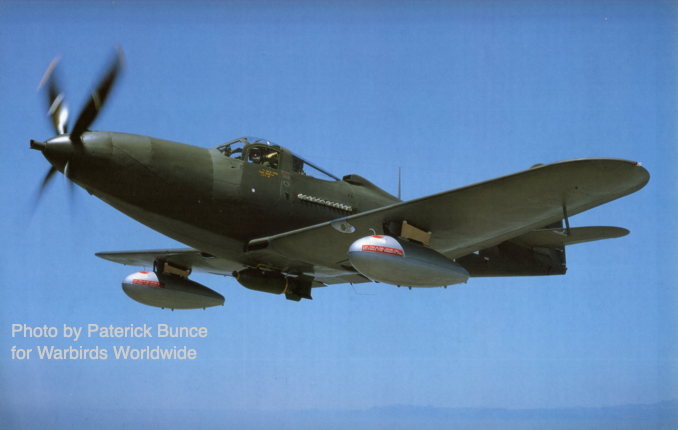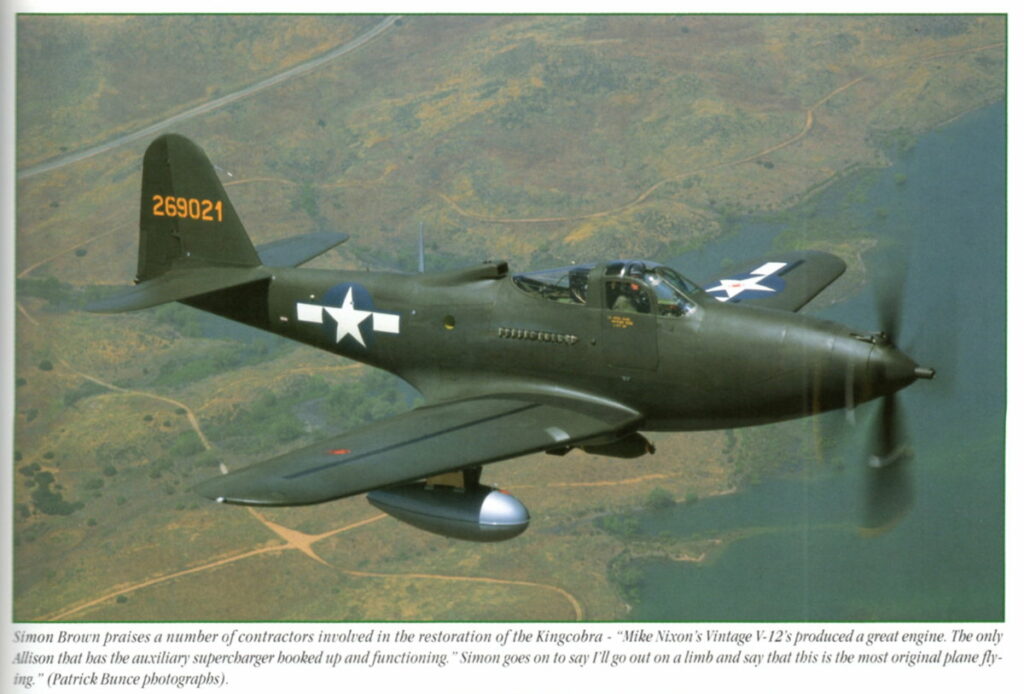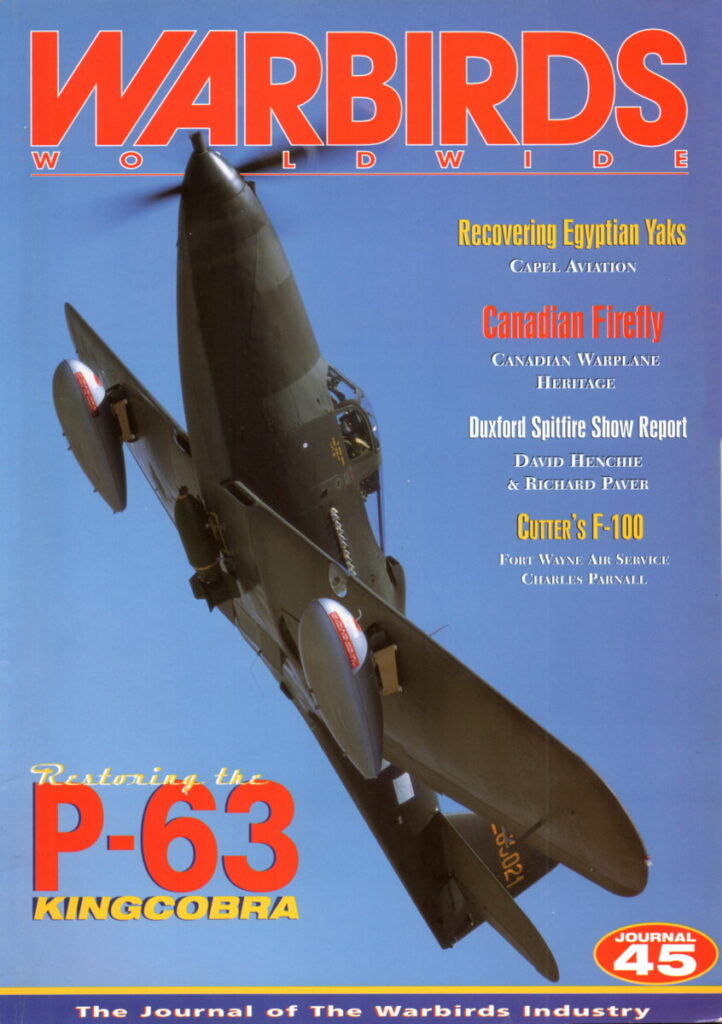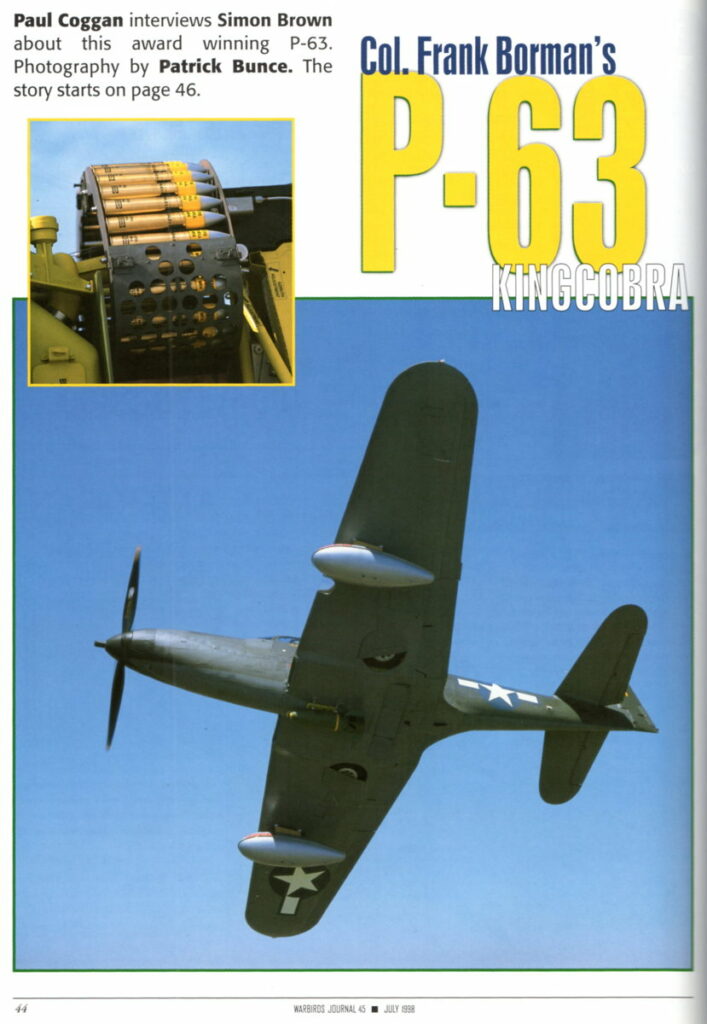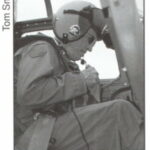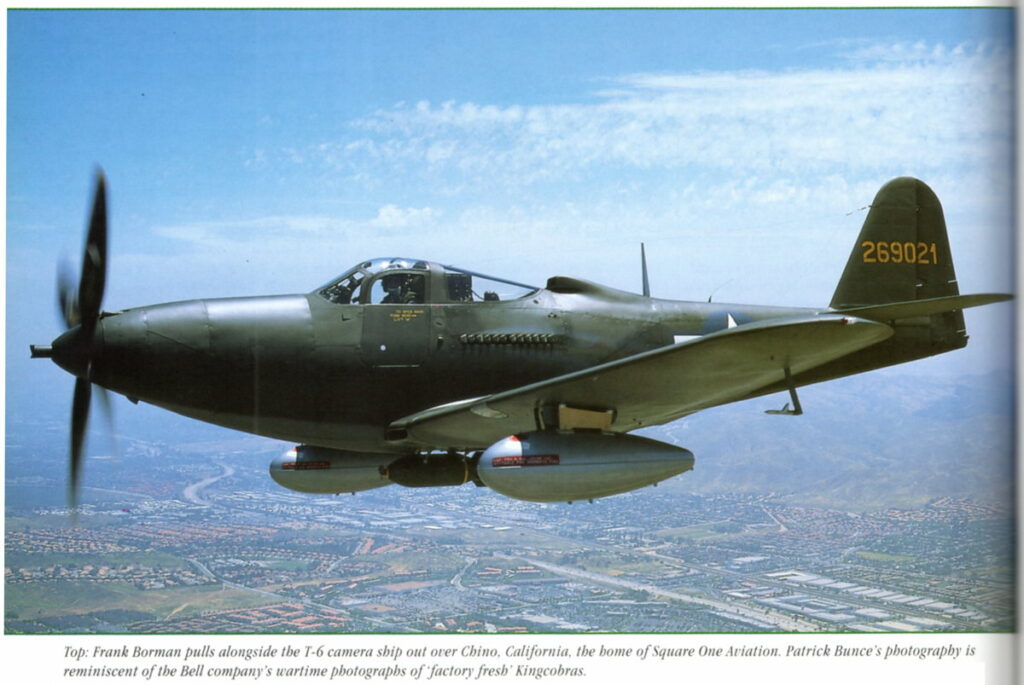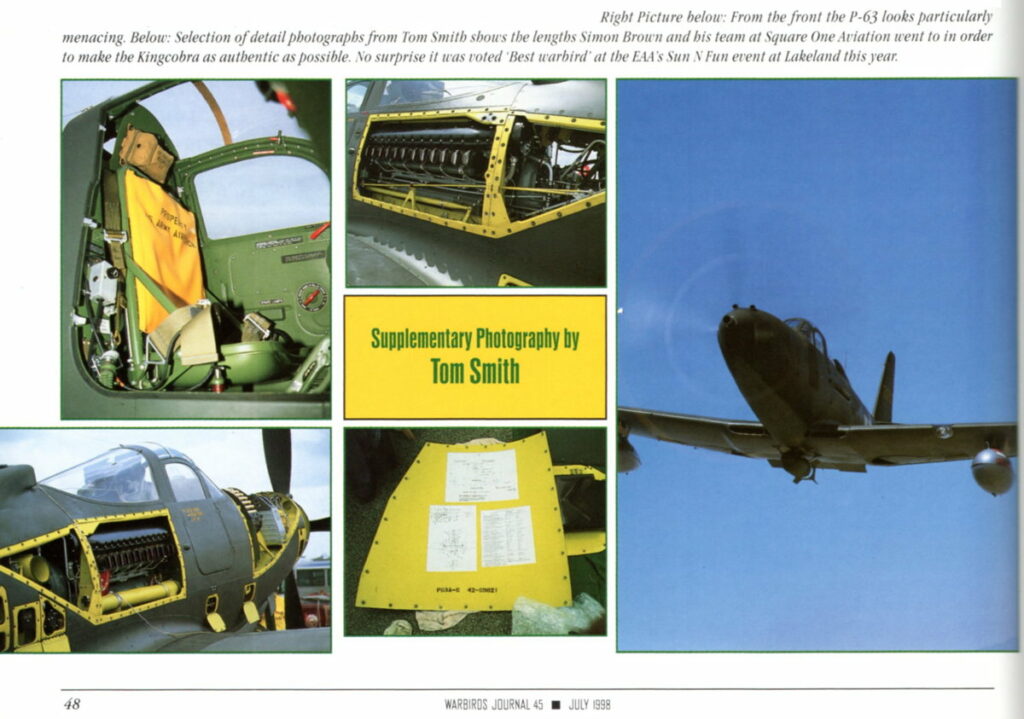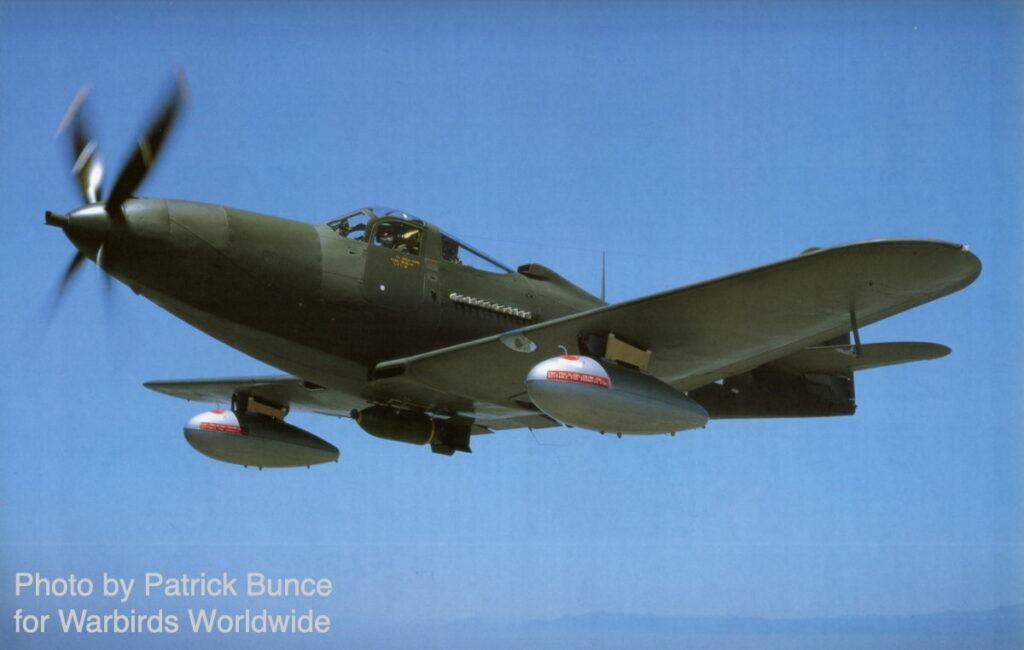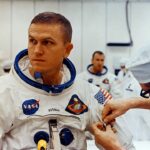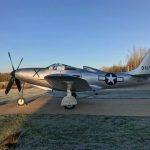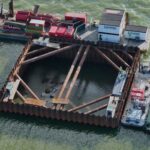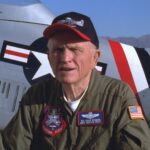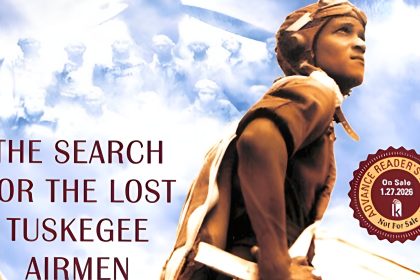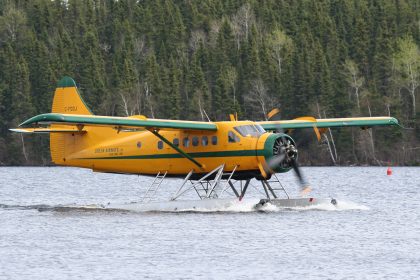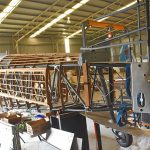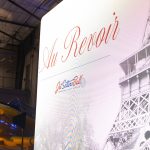We present this feature article from the July 1998 archives of Warbirds Worldwide Journal No.45 as a tribute to the late Colonel Frank Borman, USAF and astronaut who passed away in November 2023. [EAA Statement. We carry an article on his contribution to vintage aviation by Stephen Chaps.] The article features an interview with Simon Brown, then of Square One Aviation, and currently a major supporter of Vintage Aviation News with Platinum Fighter Sales. Imagery by Patrick Bunce and Tom Smith. Re-editing by James Kightly.
Rebuilding a Kingcobra – Simon Brown of Square One Aviation tells the story of a remarkable project. By the late Paul A. Coggan
Compared to the Mustang, the Bell P-63 Kingcobra is a rare aeroplane indeed. In the summer of 1996 Colonel Frank Borman commissioned Elmer Ward’s company, Square One Aviation, to restore a Bell P-63 to add to his growing collection of warbirds.
Following the presentation of the award of Grand Champion Warbird at the Experimental Aircraft Association’s Sun N Fun event at Lakeland, Florida some weeks ago Paul Coggan posed several questions to the General Manager at Square One, Simon Brown. Here are the answers –
Where was the Kingcobra discovered?
‘Van Nuys Airport in California. It had apparently been there since 1947 when it was flown in to be converted for the Thompson Trophy Races. The story goes that the ‘Cobra had a bad Centre of Gravity problem due to the removal of the guns and ammunition from the nose section. Apparently the pilot landed hard and blew all three tyres. The aircraft was then pushed into the weeds and stayed outside until 1973 when it was simply given up for tie down fees to the owner of an FBO. Amazingly, a minimal attempt was made at restoring it but it soon went back into storage. We first saw it in a T-Hangar when we did the pre-buy inspection in June 1996’.
How complete was it when you started the project?
‘Structurally it was complete. Many of the bolt on items out the cockpit had been taken by souvenir hunters. The instruments were missing and of course the armament had too. The structure was in pretty good condition. All the magnesium skins (control surfaces) and castings were brittle unusable. However, Lots of ‘cool’ original stuff was installed in the airframe. As you might expect, damage was limited to the areas of the machine where kids had crawled over it for all those years.’
How does the P-63 compare to the P-51 Mustang structure wise?
‘Both planes are rather simple in their design. Much less complicated than a Grumman Bearcat or Vought Corsair. The P-51 is extremely well laid out. The P-63 is much more – in fact very cramped and difficult to work on. I understand that Be,. idea was to put the Cannon in the nose and then figure out how to build the plane around it!’
Are spare parts difficult to get hold of for the P-63? Are that any that are impossible to obtain?
‘Yes and yes! Spares that are peculiar to Bell are difficult – and some really are impossible to obtain. We had to have missing parts made – indeed we kept the machine shop busy for months. Jay Wisler found some very neat pieces for us as well. I guess the hardest thing to find would be the 37mm cannon. After considerable research we made ours in the machine shop. We started from scratch – no documentation etc. After spending two solid days at the National Air and Space Museum at Silver Hill MD. documenting their P-63 we had al the information required to proceed.’
How much detail was required in the project? What Colonel Borman specify?
‘Frank Borman was certainly specific and his instruction was straightforward – though I hesitate to say simple: He wanted it to be the best warbird in world! Quality was to be only to the highest standard – all original. The goal was to make the 3 look like it had just rolled off the wartime production line at the Bell factory. In order to achieve this detail work was extensive.
‘We had all the blueprints which showed everything we needed. For example all the stencilling, decals, parts location. You name it – it is in blueprints – simply the best source we could for. We spent months going through these wings gleaning information and putting into practice to ensure the ‘Cobra is as accurate as humanly possible. The mission was to try and make look exactly as it was as it came off that line.
‘To finish the airframe we painstakingly had the paint colours matched, and rubber stamps were made to stamp on the part numbers – everything. Chuck Cabe even stamped the electrical wiring with the original World War II markings – and routed the wires as per the original drawings.
‘Mike Nixon’s Vintage V-12’s made us a great engine. The only Allison that has the auxiliary supercharger hooked up and functioning. I’ll go out on a limb and say that this is the most original plane flying.’
Who at Square One worked on the aircraft?
‘Everyone worked on the P-63. It was a team effort and the team consisted of: Myself – as General Manager I oversaw the entire project and made all the decisions, liaising directly with Colonel Borman as the project progressed. Paul Marak: Shop Foreman: responsible for actually building the Kingcobra. Ingo Moos: Project Leader: Tony “Bocephus” Corbo: Historical accuracy. George Skropos: Armament. Systems: Jimmie New and Greg Laird. Mechanics on the project: Randy Roy, Tom Michna, Art Jasso, Kirk Nelson, Concordio Allasada, Chris Convert, Bob Zeller, Don Smit, Wayne Tucker, Creel Carroll. Responsible for paint: Eric Jett, Jose Estrada, Dave Robbins, Rene Sauceda. Parts acquisition: Ken Smith and Mike Nightingale Secretary: Diann Morales. Chuck Cabe: tackled the electrical wiring.’
Simon also spoke highly of the people the aircraft belongs to: ‘I guess the most important people were Frank and Susan Borman – the most enthusiastic people in warbirds. They are the greatest people to build aircraft for because they appreciate the detail work and also the historical aspect. They are also our greatest supporters’ Also, in the nicest possible way the boss – Elmer Ward – although having no ‘hands on’ involvement helped out with advice and guidance on the real engineering – and also – since he owns Square One gave us the opportunity to be here to build these warbirds.’
Many enthusiasts would like to know how long the project took –
Simon volunteered “15,000+ hours (the exact number is secret). At a guess I’d say that if we just had to get it flying we could have done it in half the time. We spent a lot of time and maximum effort to put the Kingcobra in a class of its own – as perfect as possible – even to the point where we detailed areas where no one will ever see, and then more time ensuring it cuts the mustard historically. It took a while to get all the information to make it accurate. We had to spend a lot of time either searching for the parts or making replacements.’
What awards has this aircraft won so far?
‘So far – 1998 Sun N’ Fun Grand Champion Warbird. We hope to add to this list in the near future!’
Is there anything you’d do differently if you did another P-63?
‘Not really. On reflection the one thing that surprised us was the amount of work it took to research the information and material required to make it truly accurate. The next one would be a whole lot easier because we have all that documented’
Are their any companies or individuals outside Square One that you would like to mention?
‘Indeed – Mike Nixon’s Vintage V- 12’s – built a good engine. U.S. Propeller of California – did the prop overhaul. Jay Wisler – Warbirds Parts and Memorabilia in Florida – supplied lots of neat original stuff that made the difference. The National Air and Space Museum at Silver Hill – gave us access to their P-63 which was a great help. Chuck Cabe – this guy’s a genius – he did the avionics and wiring. Last but not least Bill Anders – for not buying the P-63 before Frank Borman did! There are lots of other vendors too. It literally takes an Army to build a warbird like this.’
And the headaches?
‘None really. It was a blast to build this. Fun too, since it is different to a Mustang.’
How many hours flight test did the aircraft need?
‘Ten: No major problems.’
Square One Aviation’s next project is another Mustang, and no doubt they will rise to the occasion!
The Editor [Note: the late Paul A Coggan] would like to thank Simon Brown for his invaluable assistance and patience during the preparation of this article, Colonel Frank Borman for his help securing the air to air pictures (and of course for making the whole project possible in the first place!) and Steve Hinton at Fighter Rebuilders for taking time out of a busy schedule to fly the camera ship for Patrick Bunce’s aerial sortie. [Frank Borman passed away in November 2023. We feature his historic aircraft collection in this article.]







